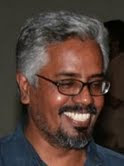Prajapati
The Prajapatis – the lord of ‘subjects’ - of Malayalam Cinema
Until recently, malayalees looked upon Tamil cinema condescendingly for their loud (literally!) depictions of superhuman heroes and utter lack of narrative logic (read naturalism). Tamil cinema indulged in impossible plot lines and supermen like Rajnikant while Malayalam cinema prided itself for its ‘realistic’ styles and stories, which actually owed to its dependence on literature.
It seems the wheel has turned full circle. Contemporary Tamil cinema has broken out of such shackles and is experimenting with bold, innovative themes, trying out startlingly new ways of story telling and picturisation. An array of talented young filmmakers have entered the field, energizing the industry and globalising it in the real sense. They freely borrow from all genres and styles to create their own heady mix of entertainment and effects – aesthetic and emotional. Unlike in Malayalam, these ‘experiments’ are happening not at the fringes or with apologetic shoestring budgets, but right at the core of the industry itself.
Watching Ranjith’s new film Prajapati, one feels that Malayalam cinema has a very long and tortuous way ahead to get out of its extreme poverty or rather poverties of styles, themes, narratives, visualization, technology and contemporariness. It is still firmly stuck in the same old narrative and stylistic prison. Prajapati narrates a primitive story that has no connection whatsoever with contemporary life or realities; the latter come as a garnishing - as some stray comments upon local politics. Even when it tries to tell a superman story, neither is it capable of achieving the technical perfection, innovativeness in visualization effects of a Tamil film, nor is it able to break free from the age-old ‘canons’ of puerile naturalism that Malayalam cinema is chained to. Like the village in the film that steadfastly keeps all the ‘ills of the contemporary’ outside, the film’s feudal mindset seems incapable of venturing outside worn-out formulae and staid dialogues (again reminding one of the early malayalee abuses on Tamil films for their lengthy and convoluted dialogues and high pitched rendering a la Sivaji Ganesan). One would be able to ‘imagine’ a village like ‘Perumalpuram’ in the film only by shutting oneself off totally from the world around, brimming with youth, new modes of life, love, living and communication, exciting technologies and gadgets, and also the extremely complicated problems and dilemmas that go with them. It is a village, ruled by a middle-aged aristocrat Devarmadom Narayanan (played by Mamootty, who is struggling to fit into the role both in terms of body as well as spoken language) is one that is ‘liberated’ from all the ‘ills of contemporaneity – industry, communication technology, politics and even judiciary, which according to the infantile logic of the film equals to degeneration, corruption and pollution. But all this purity and innocence is solely for the village lot, the prajas, while the prajapati lives in a luxurious island of modernity( which is in stark contrast to his enemy-brother family, which is still pre-modern and looks pitifully rural). His isle is animated by tillers, tractors, Plasma TV, internet, scotch (with a valet to hold the glass for him!) etc. Only difference with the earlier avatars narrated by Ranjith is that here the hero is not a connoisseur of arts! That seems to have been taken over by the shallow and crass film crew, with a heavily painted Salim Kumar masquerading as the hero. He is obviously the low culture icon of degenerate values and tastes of the contemporary or the outside world, as against the sophisticated (and fair complexioned) high-cultured insularity of the real hero.
How long will it take to reach Tamil?


0 Comments:
Post a Comment
Subscribe to Post Comments [Atom]
<< Home